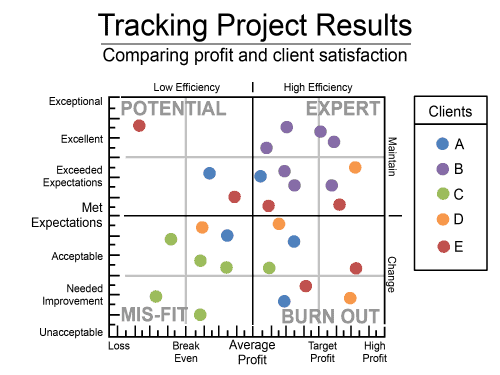“The growth of our firm has created more challenges than it has benefits.”
This is a quote from the principal of a 660-person construction firm that has been growing quickly. They went from 300 to 660 employees in just 4 years and have felt the growing pains. Several additional comments from their executive team:
“My key project managers are burning out left and right.” - Firm's CEO
“Our current staff is hitting our profits hard with overtime on some projects, and on others, we are extremely slow to deliver.” - Firm's CFO
“With us losing key staff due to burnout, and since we have so many clients aggravated with our slow delivery, our client retention is suffering greatly.” - Director of Business Development
Does this sound familiar? As a consulting and analytics leader in the AEC industry, we hear this situation a lot. Working with this firm, we helped them execute on a Voice of Client (VoC) Program to overcome these challenges and achieve their goals of:
- Retain their top talent
- Reduce wasted efforts while keeping their clients happy
- Increase profitability
Let’s look at each of these more closely and explore how a VoC program made an impact.
Retain their top talent
You know the feeling. Your computer dings to let you know an email has come in, you see the name of your most challenging client at the top of your Inbox, and your stomach flips. What is it this time? Is this email going to derail your whole day? Did the budget just blow up? Will the project margins get erased?
Managing client communication shouldn’t be a game of chance and you don’t want your top talent to experience this dread and frustration in dealing with clients. A VoC program reduces this type of dreaded email almost completely. By making small, consistent investments over time asking your clients for feedback, you gain ongoing insight into their expectations even as those expectations change. And if, occasionally, there is a surprise, the situation isn’t nearly as painful.
You want your top talent focused on delivering value to their clients. To do that, they must know what each of their clients feel is valuable. Your VoC program gives you that information and allows your team to be flexible and adjust as needed. Finally, it gives them knowledge and control, eliminating not only the existence of those surprise emails, but the fear of them as well. This empowers your team to do their best work with confidence, a benefit that is priceless both to them and to your firm.
Reduce wasted efforts while keeping their clients happy
Wasted effort on projects causes employee and profitability issues. A consistent VoC program helps identify and address project delivery issues related to wasted (or unnecessary) effort. The information also allows your team to manage client expectations, and then deliver on them. Figure 1 illustrates this point.
The individuals in this chart are all project managers (PMs) for Acme Engineering. At the top of the chart, Chris has the highest average score (6.6 out of 7.0) while (Dan) has a score that is more centered, showing a little above Met Expectations (4.6 out of 7.0).
If you take the information on this chart at face value, it’s logical to decide that Chris is doing a better job than his colleagues (and definitely a better job than Dan). However, when you add profitability metrics for the PMs a different story emerges. Chris has a profitability of 3% and Dan is sitting at 38%.
When management reviewed these metrics, they asked questions. They found that Chris, a relatively new PM, was providing his clients with a lot more than they asked for (and paid for) to make sure they were happy. The extras Chris provided kept his clients happy, but he was contributing to his team’s burnout and his project’s lack of profitability. Chris wasn’t setting clear expectations about project delivery – for himself or his clients – so he was giving away services.
Dan, on the other hand, was a more experienced PM who set clear and very high expectations on his projects. He delivered on those expectations and his clients were happy, he met their expectations. Any add-ons during project delivery were communicated effectively, captured in change orders, and associated invoices. Clients were happy, and his projects remained profitable.
The information from their VoC program combined with percent profitability provided a coaching moment for Chris. He was able to better understand ways to manage his projects that met his clients’ expectations and delivered what they needed without giving away services. Over time his percent profitability increased.
Increase profitability
As your firm grows, increasing your share of wallet with key clients or in disciplines where your firm is a strong performer is a good strategy to maintain or increase profitability. The question is: do you have the data you need to do this effectively?
When considering the data needed to execute this strategy, it’s important to the consider the value and type of data available. It’s easy to get quantitative data on profitability.
You simply run reports on the profitability of key clients or various disciplines. But does this give you all the information you need? Are you using your gut and/or conversations with your clients to gather the information you need on the relationships involved? Is all your relationship data subjective?
Most people are uncomfortable having difficult conversations. Your team and your clients are no exception. While personal conversations are important to the relationship, their success is difficult to measure. Using a VoC program gives clients the chance to express their perceptions about service delivery in a comfortable way that also allows you to add a quantifiable measurement to your strategy.
Figure 2 shows a quadrant report that allows firms to measure profitability against client perception. The X axis tracks profitability, and the Y axis tracks average sentiment based on several variables (clients, disciplines, regions, etc.).
This figure shows the ability to track profitability and client perception for a list of key clients. The flexibility of this tool allows you to track these results based on client type, discipline, office, region, etc. (See Feedback Quadrant - The missing axis of information) for more information on the quadrant report details.
Busy teams can’t afford NOT to ask for feedback. Growth is positive and exciting. It can also be stressful and costly. Using quantifiable data to ensure your team, your clients, and your profitability are being taken care of will make that growth sustainable. Client Savvy has the tools that can help you achieve your growth and profitability goals while reducing or eliminating these challenges







